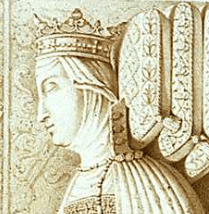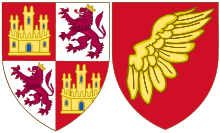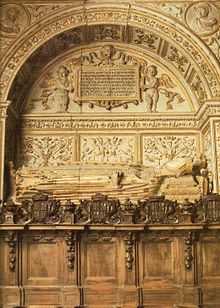Juana Manuel
| Juana Manuel | |
|---|---|
 | |
| Queen consort of Castile and León | |
| Tenure | 1369–1379 |
| Spouse | Henry II of Castile |
| Issue |
John I of Castile Eleanor, Queen of Navarre Infanta Joanna |
| House | House of Ivrea |
| Father | Juan Manuel, Prince of Villena |
| Mother | Blanca Núñez de Lara |
| Born | 1339 |
| Died |
27 March 1381 (aged 41–42) Salamanca |
| Burial | Cathedral of Toledo |
| Religion | Roman Catholicism |

Juana Manuel of Castile (1339 – 27 March 1381) was Queen consort of Castile from 1369 until 1379. She also was the heiress of Escalona, Villena, Peñafiel and Lara, as well as Lady of Biscay.
Family
She was the daughter of the Infante Juan Manuel of Castile (1282–1349) and his second wife Blanca Núñez de Lara de La Cerda. Her mother Blanca (d. 1347) was a descendant of the Lords of Biscay and of Lara and of Alfonso X's eldest son (Fernando de la Cerda). She was the last legitimate member of the House of Ivrea.
Marriage
Her father had been for five years a serious enemy of King Alfonso XI, his former protégé, and the king wished to neutralize or absorb the might of the Peñafiel family. Although Juana was not the heiress (yet), already in her youth she had to go along with royal wishes. The king's very influential concubine, Leonor de Guzmán, wanted to obtain some high prestige and property to her eldest son and had her eyes on the young Juana. On 27 July 1350 her brother and guardian, Fernando Manuel of Peñafiel, had to marry his young sister to Henry (1333–79), eldest of the illegitimate sons of Alfonso XI of Castile. This brought Henry certain lands.
However it was later that Juana's relatives' heirless deaths made Juana the great heiress she turned out to be: so important an heiress that actually her husband gained the opportunity to be a threat to the royal power. She had more rights to the throne of Castile than her husband because she was a legitimate descendant of Alfonso X of Castile. In 1369, Henry became King Henry II of Castile, after he deposed (and murdered) his half-brother to take the throne.
They had the following children:
- King John I of Castile (1358–1390)
- Eleanor (died 1416) [1]
- Joanna
Inheritance

In 1361 (at the death of her teenage niece Blanca,[2] daughter of her half-brother Fernando Manuel who himself had died in c 1350 without other children) she inherited Villena, Escalona and Peñafiel.[3] Because Juana was a maternal granddaughter of La Palomilla, from her another cousin, Isabel de Lara who was murdered in 1361 [4] and her young daughter Florentina [5] (d after 1365), she also inherited Lara and Biscay. In 1369, she became queen of Castile and León.
When in 1381 she died and left her inheritance to her son, Biscay finally was united with Castile, and ultimately Spain. The Basque people remember her for that.
Ancestry
| Ancestors of Juana Manuel | ||||||||||||||||||||||||||||||||||||||||||||||||||||||||||||||||||||||||||||||||||||||||||||||||||||||||||||||||||||||||||||||||||||||||||||||||||||||||||||||||||||||||||||||||||||||||||||||||||||||||||||||||||||||||||||||||||||||||||||||||||||||||||||||||||||||||||||||||||||||||||||||||||||||||||||||||||||||||||||||||||||||||||||||||||||||||||||||||||||||||||||||||||||||||||||||||||||||||||||||||||||||||||||||||||||||||||||||||||||||||||||||||||||||||||||||||||||||||||||||||||||||||||||||||||||||||||||||||||
|---|---|---|---|---|---|---|---|---|---|---|---|---|---|---|---|---|---|---|---|---|---|---|---|---|---|---|---|---|---|---|---|---|---|---|---|---|---|---|---|---|---|---|---|---|---|---|---|---|---|---|---|---|---|---|---|---|---|---|---|---|---|---|---|---|---|---|---|---|---|---|---|---|---|---|---|---|---|---|---|---|---|---|---|---|---|---|---|---|---|---|---|---|---|---|---|---|---|---|---|---|---|---|---|---|---|---|---|---|---|---|---|---|---|---|---|---|---|---|---|---|---|---|---|---|---|---|---|---|---|---|---|---|---|---|---|---|---|---|---|---|---|---|---|---|---|---|---|---|---|---|---|---|---|---|---|---|---|---|---|---|---|---|---|---|---|---|---|---|---|---|---|---|---|---|---|---|---|---|---|---|---|---|---|---|---|---|---|---|---|---|---|---|---|---|---|---|---|---|---|---|---|---|---|---|---|---|---|---|---|---|---|---|---|---|---|---|---|---|---|---|---|---|---|---|---|---|---|---|---|---|---|---|---|---|---|---|---|---|---|---|---|---|---|---|---|---|---|---|---|---|---|---|---|---|---|---|---|---|---|---|---|---|---|---|---|---|---|---|---|---|---|---|---|---|---|---|---|---|---|---|---|---|---|---|---|---|---|---|---|---|---|---|---|---|---|---|---|---|---|---|---|---|---|---|---|---|---|---|---|---|---|---|---|---|---|---|---|---|---|---|---|---|---|---|---|---|---|---|---|---|---|---|---|---|---|---|---|---|---|---|---|---|---|---|---|---|---|---|---|---|---|---|---|---|---|---|---|---|---|---|---|---|---|---|---|---|---|---|---|---|---|---|---|---|---|---|---|---|---|---|---|---|---|---|---|---|---|---|---|---|---|---|---|---|---|---|---|---|---|---|---|---|---|---|---|---|---|---|---|---|---|---|---|---|---|---|---|---|---|---|---|---|---|---|---|---|---|---|---|---|---|---|---|---|---|---|---|---|---|---|---|---|---|---|---|---|---|---|---|---|---|---|---|---|---|---|---|---|---|---|---|---|---|---|---|---|---|---|---|---|---|---|---|---|---|---|---|---|---|---|---|---|---|---|---|---|---|---|---|---|---|---|---|---|---|---|---|---|---|---|---|---|---|---|---|---|---|---|---|---|---|---|---|---|
| ||||||||||||||||||||||||||||||||||||||||||||||||||||||||||||||||||||||||||||||||||||||||||||||||||||||||||||||||||||||||||||||||||||||||||||||||||||||||||||||||||||||||||||||||||||||||||||||||||||||||||||||||||||||||||||||||||||||||||||||||||||||||||||||||||||||||||||||||||||||||||||||||||||||||||||||||||||||||||||||||||||||||||||||||||||||||||||||||||||||||||||||||||||||||||||||||||||||||||||||||||||||||||||||||||||||||||||||||||||||||||||||||||||||||||||||||||||||||||||||||||||||||||||||||||||||||||||||||||
References
- ↑ Juana Manoel de Castilla
- ↑ Marek, Miroslav. "(Blanca's death)". Genealogy.EU.
- ↑ Cawley, Charles, (inheritance of the 'greatest' castilian patrimony), Foundation for Medieval Genealogy, retrieved August 2012,
- ↑ Marek, Miroslav. "(Isabel's death)". Genealogy.EU.
- ↑ Marek, Miroslav. "(Florentina's death)". Genealogy.EU.
| Juana Manuel House of Ivrea Born: circa 1339 Died: 27 March 1381 | ||
| Regnal titles | ||
|---|---|---|
| Preceded by Blanche of Bourbon |
Queen consort of Castile and León 1359–1369 |
Succeeded by Eleanor of Aragon |
| Spanish nobility | ||
| Preceded by Blanca Manuel |
Lady of Villena, Escalona and Peñafiel 1361–1381 |
Incorporated into the Crown of Castile |
| Preceded by Tello Alfonso |
Lord of Biscay and Lara 1370–1379 |
Succeeded by John II of Castile |